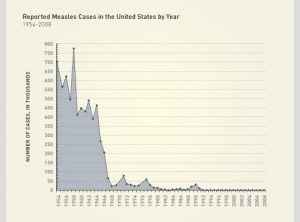Jun 05 2017
Minnesota Measles
 There is currently a measles outbreak in Minnesota. This was, unfortunately, entirely predictable – not, of course, that an outbreak would occur specifically in Minnesota, but that we would start to see outbreaks in communities with low vaccination rates.
There is currently a measles outbreak in Minnesota. This was, unfortunately, entirely predictable – not, of course, that an outbreak would occur specifically in Minnesota, but that we would start to see outbreaks in communities with low vaccination rates.
So far Minnesota has seen 73 cases of measles. This is more than any year in the last 20 years (or more, that is how far back the tables go). In fact, that is more than all Minnesota cases combined in the last 20 years (56).
Nationwide we hit our low point for measles in 2004 with only 37 cases, all imported from other countries. This means that measles we eliminated from the US, with no native reservoir and no endemic cases. Measles, of course, has not been eradicated from the world and so we can still have imported cases. Thirty seven cases is down from the millions that would occur each year prior to the introduction of vaccines. The graph shows reported cases, which were as high as 800 thousand, but the CDC estimates that the real number was much higher as most cases went unreported.
There is no mystery what is going on – the modern anti-vaccine movement has been effective in spreading false fear about vaccines. Since 2004 the number of measles cases has been climbing. The recent peak was in 2014 with 667 cases, due largely to the Disney outbreak.
A Vulnerable Community
Something else happened in 2004 – Andrew Wakefield visited Minnesota. There is a Somali community there and they had been experiencing a relatively high number of cases of autism. They did not understand why there was a cluster of cases, and the cultural barrier complicated efforts to provide answers. I first wrote about this apparent cluster in 2008. In 2013 a long term study confirmed that there is a cluster in Minneapolis in general, but in greater numbers among Somali children.
There is also a cluster among Somali immigrants in Sweden, but not in other locations. The cause of these clusters is not currently known. Preliminary evidence suggests that low vitamin D levels may be playing a role, which makes sense for a dark-skinned population migrating to higher latitudes. It is also possible that the population simply has a higher genetic predisposition to autism which is just being recognized when they move to countries with better access to health care and services.
In 2004 the Minnesota Somali community had high vaccination rates, >90%. Then, after Wakefield’s visit, fear started spreading through the community that vaccines were the cause of autism. Vaccine compliance plummeted, and today less than half of Somali children in Minnesota are vaccinated.
This represents the predatory targeting of a vulnerable community by an ideological group for propaganda purposes. There is a direct correlation between anti-vaxxers targeting the Somali community and dropping vaccine rates, followed predictably by disease outbreaks.
The only thing we can do now is reach out to this community with efforts to educate them about the safety of vaccines in the hopes that vaccination rates will increase. However, once a fear is instilled it is difficult to eradicate. That is the more pernicious virus at work here.
This episode and the entire anti-vaccine movement also represents the hidden risk of the alternative medicine / appeal to nature narrative which is currently on the upswing. Ideas have a lot of cultural inertia, especially once they become embedded to the point that many people just take them for granted, and incorporate them into their world view and self-identity.
The notion that medical authorities are compromised and cannot be trusted, but that purveyors of natural cures are trustworthy is nothing but marketing propaganda for snake oil. And yet this propaganda has been remarkably successful, because it is selling an emotionally compelling narrative. That narrative is not aligned with reality and has tremendous potential to cause harm.
The Somali measles outbreak is just one tiny example.






